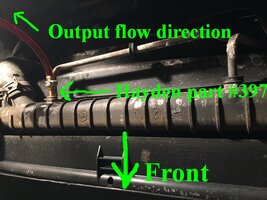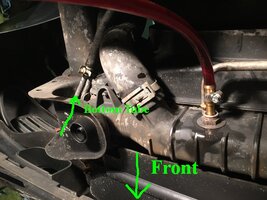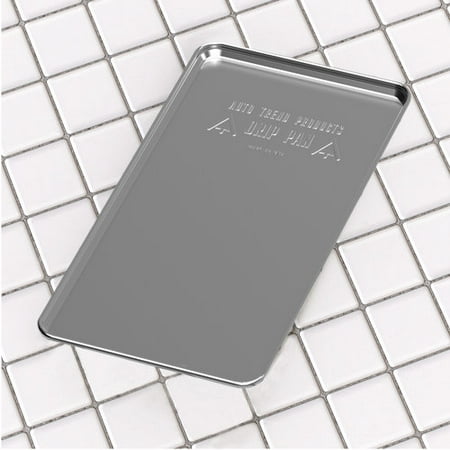- May 4, 2014
- 38
I did hours of searching and could not find anything definitive for this matter. I keep reading how some guys say to pull the drivers side tube and some say the passenger side tube. Then they do not indicate if you should attach a piece of rubber tubing to the metal tube or directly to the transmission.
To end this pitiful nonsense, I took some photos today of me doing this. For starters, I strongly recommend that you spend the $10 for the Hayden transmission adapter part #397 as this works with almost every GM vehicle I've done these flushes on.
Transmission:
1. Remove transmission pan, clean the magnet, and replace filter. The TB is the easiest GM truck I've ever done this on.
2. Remove the c-clip from the LEFT SIDE (Drivers Side) port on the bottom of the radiator.
3. Pull out the metal transmission tubing - it may drip a little.
4. Insert the brass Hayden adapter and replace the c-clip you just removed.
5. Attach a vinyl hose to the brass adapter and secure the other end into a bucket (it will fly out if you don't secure it).
6. Add five quarts to the transmission via a funnel and dipstick tube.
7. Start up the engine and run it until the fluid color changes - DO NOT RUN OUT OF FLUID - have someone fill it while it is running.
8. Pull the c-clip, re-attach the metal transmission tubing, re-install c-clip.
9. Check fluid level in transmission; add as necessary. Go for a test drive and re-check fluid.
*Note - If doing this alone, run the engine incrementally so you can stop it and refill the transmission sump.
My power steering fluid was almost black. I flushed it as noted below and shown in the bottom photo:
Power Steering:
1. Suck fluid out of the reservoir via a turkey baster or preferably use a Mity-Vac pump to suck it all out.
2. Find the rubber hoses that attach to the power steering fluid cooler at the underside of the front bumper (see photo).
3. Unclamp the bottom-most and most easily accessible hose and pull the rubber hose tubing off.
4. Attach a piece of vinyl tubing directly onto the metal cooler nipple - no clamp necessary.
5. Fill the reservoir with fresh fluid (note that the rubber tubing you disconnected will slowly drip fresh fluid - no big deal).
6. Turn the wheel to the left and to the right several times; I did about eight times left/right and then refilled reservoir.
7. Continue doing this until the fluid coming out of the tube is clear.
8. Re-attach the rubber tubing and re-clamp.
9. Check fluid level.
I went through about 2 qts of power steering fluid. Gallon of Valvoline cost me like $17 at Advance.
To end this pitiful nonsense, I took some photos today of me doing this. For starters, I strongly recommend that you spend the $10 for the Hayden transmission adapter part #397 as this works with almost every GM vehicle I've done these flushes on.
Transmission:
1. Remove transmission pan, clean the magnet, and replace filter. The TB is the easiest GM truck I've ever done this on.
2. Remove the c-clip from the LEFT SIDE (Drivers Side) port on the bottom of the radiator.
3. Pull out the metal transmission tubing - it may drip a little.
4. Insert the brass Hayden adapter and replace the c-clip you just removed.
5. Attach a vinyl hose to the brass adapter and secure the other end into a bucket (it will fly out if you don't secure it).
6. Add five quarts to the transmission via a funnel and dipstick tube.
7. Start up the engine and run it until the fluid color changes - DO NOT RUN OUT OF FLUID - have someone fill it while it is running.
8. Pull the c-clip, re-attach the metal transmission tubing, re-install c-clip.
9. Check fluid level in transmission; add as necessary. Go for a test drive and re-check fluid.
*Note - If doing this alone, run the engine incrementally so you can stop it and refill the transmission sump.
My power steering fluid was almost black. I flushed it as noted below and shown in the bottom photo:
Power Steering:
1. Suck fluid out of the reservoir via a turkey baster or preferably use a Mity-Vac pump to suck it all out.
2. Find the rubber hoses that attach to the power steering fluid cooler at the underside of the front bumper (see photo).
3. Unclamp the bottom-most and most easily accessible hose and pull the rubber hose tubing off.
4. Attach a piece of vinyl tubing directly onto the metal cooler nipple - no clamp necessary.
5. Fill the reservoir with fresh fluid (note that the rubber tubing you disconnected will slowly drip fresh fluid - no big deal).
6. Turn the wheel to the left and to the right several times; I did about eight times left/right and then refilled reservoir.
7. Continue doing this until the fluid coming out of the tube is clear.
8. Re-attach the rubber tubing and re-clamp.
9. Check fluid level.
I went through about 2 qts of power steering fluid. Gallon of Valvoline cost me like $17 at Advance.



 Dorman pan with a drain plug is already waiting in my parts stash
Dorman pan with a drain plug is already waiting in my parts stash 

